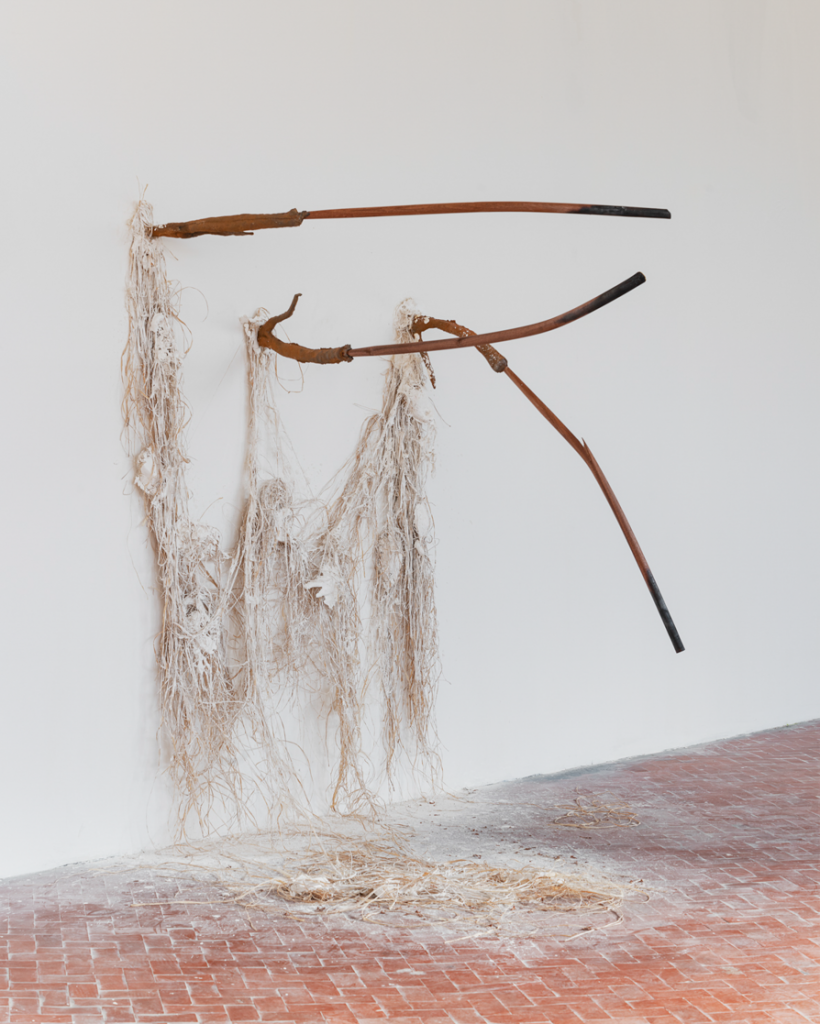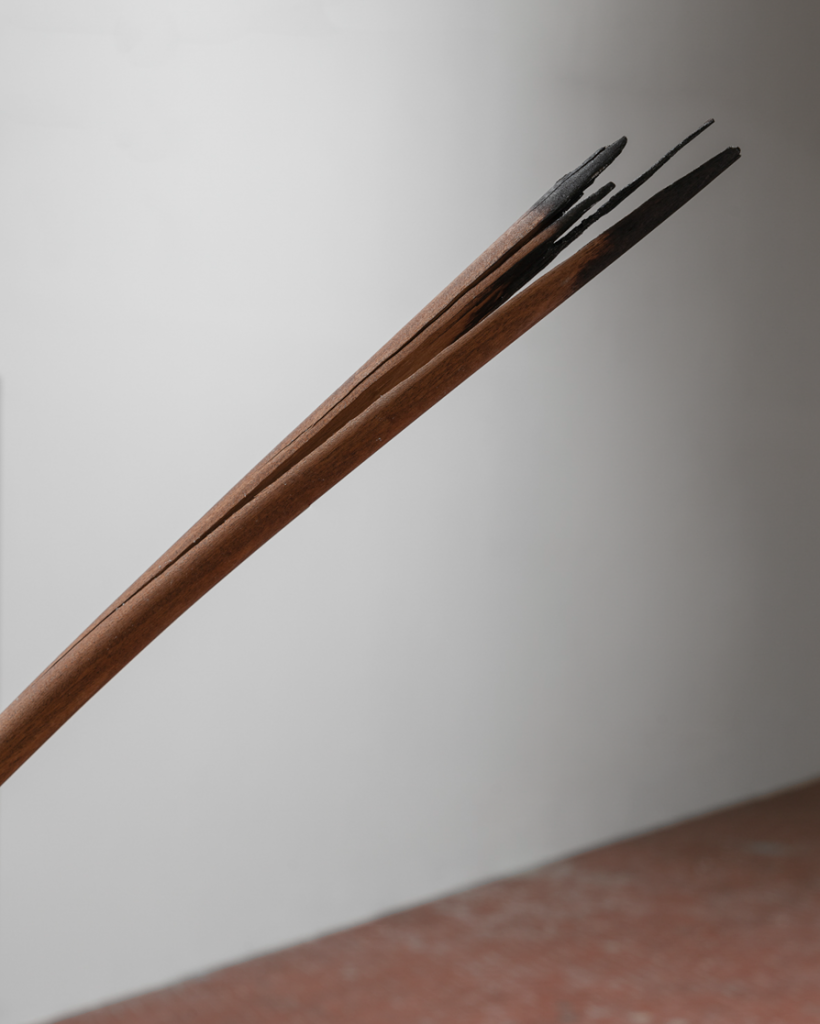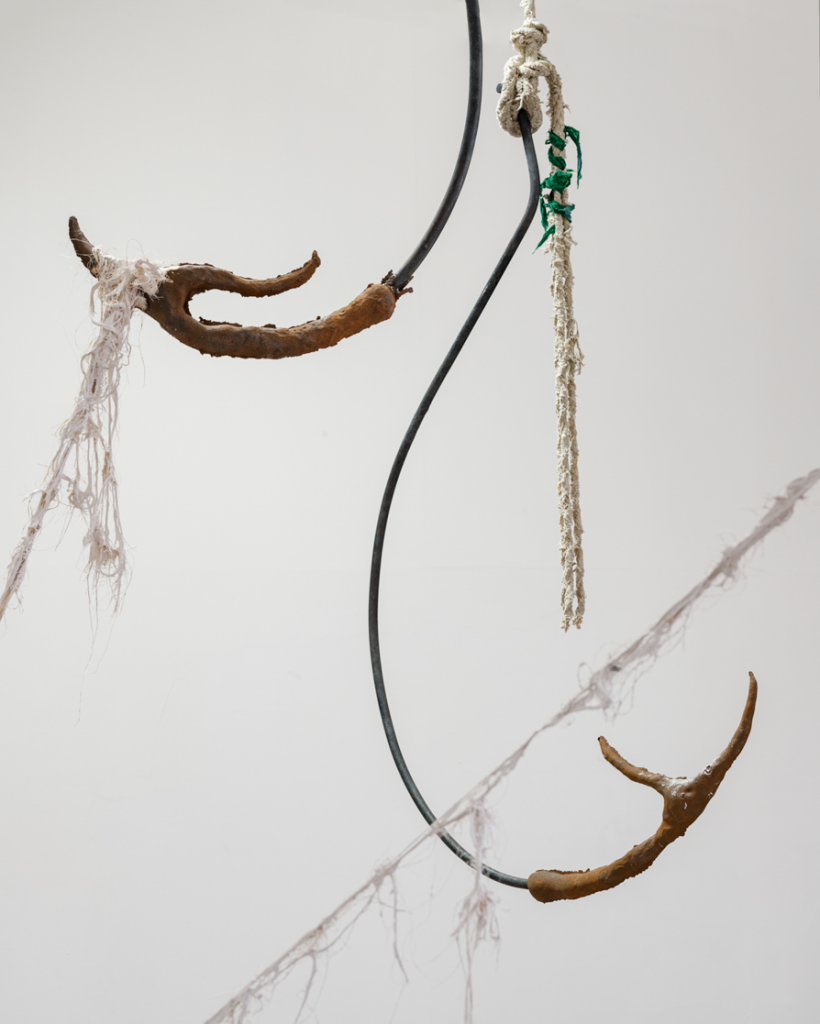Dominique White. Reifying Abysses
 Hydra Decapita, Dominique White’s second solo exhibition at VEDA, Florence, on view through January 15 2022, unfolds as a complex interplay, where various levels of legibility, full of distortions and conflicts, exert such pressure as to remain suspended, one against the other, in space, a speculative sea that nothing rejects and everything, constantly, stirs.
Hydra Decapita, Dominique White’s second solo exhibition at VEDA, Florence, on view through January 15 2022, unfolds as a complex interplay, where various levels of legibility, full of distortions and conflicts, exert such pressure as to remain suspended, one against the other, in space, a speculative sea that nothing rejects and everything, constantly, stirs.
White’s work is profoundly linked to certain themes, such as Black Subjectivity, nautical myths of Black Diaspora, Detroit techno and Afro-futurism/pessimism which, continuously intertwined with each other, are knotted together creating ever new plots.
The text aims to trace the forms and survivals of these elements in Hydra Decapita, outlining in broad strokes the conceptual horizon that moves White’s practice and the marine context in which it takes place.

Dominique White (UK, b.1993) is a talented young Marseille-based artist who has already held important solo exhibitions in Italy, France, Norway and Austria, and since 2019 has been working side by side with VEDA, obtaining important awards such as the Roger Pailhas prize at Art-O-Rama (2019) and the Fondazione Merz prize at Artissima (2021). For Hydra Decapita she moved to Florence where for over a month she turned the gallery into her workshop (still today you can find the traces just entering the space) forging relationships with local craftspeople and working site-specifically.
The environment that hosts White’s speculations is the sea, which becomes possible (and tangible!) place to re-write and re-imagine a history and a future for Blackness. Theater of clashes and misfortunes (this is where the concept of Blackness comes to life with the African slave trade) the sea nevertheless preserves the hope and fascination of the submerged, the invisible, the forgotten that, under the surface, actively elaborates a new world.

White draws on a wide range of artistic, literary, and musical references to position her practice, which appears more properly to be a political and radical positioning. For Hydra Decapita one of the references is The Many-Headed Hydra: Sailors, Slaves, Commoners, and the Hidden History of the Revolutionary Atlantic (2000) by P. Linebaugh & M. Rediker, whose idea is, however, distorted and reversed: the heads of the Hydra are not for White “the pirates, runaway slaves, and commoners who threatened the formation of capitalism and the structure of colonialism in the 17th century,” but rather the State “whose heads represent the many facets of capitalism, colonialism, and anti-blackness.” The overthrow is powerful. The State is expressed through cast iron harpoons with a linear mahogany body. The body is partially burned and decaying, slender but durable, worn and deceptively charming. The cast iron harpoons seek to establish a relationship, to grab onto something, to support themselves. Sometimes they touch the ground, sometimes they are embedded in walls, and sometimes, like a plant moving in response to light stimuli, they seem to bend the top toward the light. In May you break free and outlive your enemy, the harpoons multiply and find a structure: but it is not they who find rest in the contact with the material, they act as a hook for a jumble of kaolin-soaked materials that remain magically suspended at mid-height, in tension, in an operation that at first glance seems to be resurfacing, as if the objects were fished out of the sea, but then the doubt arises: could the movement be instead of re-immersion in the sea?

The marine metaphor is ubiquitous in White’s vocabulary and is articulated firstly by elaborating frames of found materiality. Null sails, sisal, kaolin clays, worn ropes, raffia, cowrie shells, it is from these materials and from the use she makes of them that White communicates her devotion to the sea. It is White’s great virtue to keep in balance the suffered, activist, profound cultural horizon that nourishes her work with its actual formal expression. Indeed, this unstable relationship never sacrifices form to give rise to ideas. White’s works condense all these tensions and transport the spectator inside a world made of ruins, decay and deterioration that, however, sometimes heroically, sometimes tragically, sustains itself (look at Ruttier for the Absent, 2019, conceived during Curva Blu Residency at Punta Marsala on the Italian island of Favignana).

The Hydra myth, an image of the water element, in its chaotic and therefore dangerous aspect towards the cosmos, is only the last of the ancient myths that have crossed White’s art. Previously and simultaneously, another theory, which merges with mythic narration, seems to deeply influence the artist’s storytelling. In Fugitive of the State(less), the first solo show in Italy, at VEDA, Florence, 2019, but also in Abandon(ed) Vessel at Kevin Space, Vienna, 2019, it is the Drexciyan myth that flows into her practice. In Hydra Decapita the focus is altered but Drexciyan influences still seem to permeate the scene.
To fully embrace the myth of Drexciya one needs to get into the nascent Detroit techno scene of the 90s, in particular recovering the experience of the duo Drexciya, which consisted of James Stinson and Gerald Donald. From the beginning of the 90s to 2002 the Detroit-based duo released a series of recordings that operated as the vehicle for the creation of a myth of a neo-Atlantis, a fictional world system titled Drexciya, a sub-aquatic country populated by the unborn children of pregnant women who were thrown overboard during the middle passage of slave ships across the Atlantic, as revealed in the sleeve notes to their 1997 album The Quest.

The Afrofuturist theories and the underground resistance of Drexciya and Detroit techno and electronic music influence White both visually and conceptually. For example, her use of the term Shipwreck(ed), redefined both as “a reflexive verb and a state of being” also ties into this imagery. At the same time, Drexciya is an important source for another group of contemporary curators and artists who work extensively on the decolonization of knowledge and image in the contemporary, The Otolith Group, an artist-led collective and organization founded by Anjalika Sagar and Kodwo Eshun in 2002.
White, on the occasion of Hydra Decapita at VEDA, seems to remediate Drexciya starting precisely from the work of Otolith Group, who, in turn, reimagine the Drexciyan experience through a film commissioned for Manifesta 8 in 2010, titled namely ‘Hydra Decapita‘. The connection seems anything but coincidental; Otolith Group’s ‘Hydra Decapita’ investigates the imaginary space of the Detroit electronic music duo approaching Drexciyan mythology by assembling “a sense of poetic relationships, images that seek to replace the evidence of things not seen.”
 In the exhibition at VEDA and, more generally, in White’s poetics we find many hidden layers. The constellation of suggestions, references, imagery that her practice stimulates, sometimes more explicitly, sometimes more implicitly, feeds the desire to approach forms and navigate them, in a movement that turns into sound, the sound of Drexciya, an element so overexposed as to be the only thing that actually disappears.
In the exhibition at VEDA and, more generally, in White’s poetics we find many hidden layers. The constellation of suggestions, references, imagery that her practice stimulates, sometimes more explicitly, sometimes more implicitly, feeds the desire to approach forms and navigate them, in a movement that turns into sound, the sound of Drexciya, an element so overexposed as to be the only thing that actually disappears.

